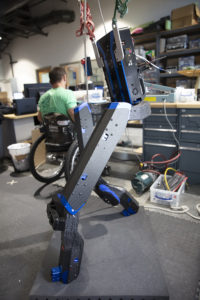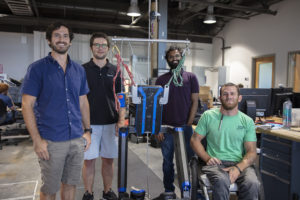Pensacola team puts its wearable technology to the test over homemade terrain
Researchers at the Institute for Human and Machine Cognition (IHMC) based in Pensacola, Fla., had been creating exercise devices for astronauts and bipedal robots when they got a “wild hair” in 2010. They wanted to see what would happen if they attached a human body to their upright exoskeleton design. Pensacola native Mark Daniel quite literally stepped into that challenge.
Daniel took one spin in the team’s first robotic wearable device and, from step one, showed them that everything about the original design, for practical use, was wrong. Years of research and trials followed.

Fast forward to 2016 inside a stadium in Zurich, Switzerland, where IHMC’s Cybathlon pilot Daniel powered the Mina v2 model, sponsored by Star Prototype, through six tasks in a 10-minute time frame against 70 robot-aided athletes from 25 countries. Daniel was that year’s silver-medal finisher in the powered exoskeleton races. This year, they will compete virtually from their home base on Saturday, Nov. 13. Daniel will be interacting with the latest exoskeleton device, called Quix, which makes walking more reliable by adding ankle flexion and lateral hip rotation. These improvements were showcased during the team’s recent participation in Toyota’s first Mobility Unlimited Challenge.

Since the 2020 Cybathlon is going to be filmed, organizers had to build a course by hand – using Ikea furniture – inside IHMC’s 10,000-square-foot building. To mimic the stadium environment for filming, lights were added, along with spotters, a referee and timekeeper, who signals the beginning and end of each obstacle and then inputs data into the machine’s tracking system.
Test runs have clocked Daniel at a completion time of 7 minutes for obstacles that include stacking cups, climbing stairs, descending ramps and navigating a patch of rough terrain, said team lead Robert Griffin.
“Our goal is to give Mark more degrees of freedom, with the minimum amount of effort that any user of this technology has to exert to use it,” he said.
The team has come a long way from assuming that a prerecorded motion can be executed perfectly by someone with no motor control like Daniel, who is paralyzed as a result of a car accident which left him without mobility in his lower limbs. Rather than giving up at 18 years old, he focused on excelling at physiotherapy and now works at IHMC as a builder and designed his own off-road wheelchair.
“If you want to get hard things done, ask someone doing hard things,” he said.
Task Trajectory
Exoskeletons are a promising technology to enable those with limitations to walk again without being at the mercy of artificially stimulated movement. As the 2016 Cybathlon illustrated, however, having the capability to perform in daily life is still in the future.
“For any candidate, it’s about finding that sweet spot after injury occurs,” Griffin said. “When the person is still comfortable with the sensations of being upright, but are firmly aware of what their body needs and how that reacts that makes this successful.”
Daniel said his current device is still pretty dumb in the smart world.

“I have to take over all the smart capabilities, which are decision making, all the directional routing, balancing and cycling between modes; everything that is not the mechanical motion of walking,” he said.
But Daniel does more than strategize where his feet land. Walking around in an exoskeleton sounds like snowshoeing, as he clicks and beeps his way through the course, transferring foot position and step length by pressing buttons on his two crutches.
Griffin credits Daniel’s early feedback before his time on the team for today’s software development.
“The focus is on a task, like sitting or standing,” Griffin said. “But to do it best is not about being high-tech, rather having a high-performance solution.”
He said most exoskeletons power only the hip and knee flexion, whereas Quix has eight actuators at the necessary joint positions.
Completion of the Cybathlon course means collecting points for each area, so in 2016, when none of the exoskeleton teams qualified to do all the tasks, IHMC had to choose.
“Even if we did them two minutes slower or faster, we still would have been second [place] because those we skipped were worth more than the first-place finisher,” Griffin said. “Plus, the pilot from ReWalk Robotics (Germany) had been using their commercial model every day for years.”
Novel coronavirus (COVID-19) pandemic restrictions sent the team home for one month, and Griffin came down with the virus two weeks before showtime.
“The goal is to do it as fast as possible given the current settings for this device,” he said. “It’s not like running a foot race, where if we try harder, we can automatically go faster. It is about playing our game based on how we planned it.”
Overall, Griffin thinks the Cybathlon’s success story will be that competing helped create a device that didn’t exist that now benefits people.
“It is tough losing the competition environment, and even though pilots need to have a certain strength to maneuver, I think the ideas are sound, plus possibilities are there, so we will be able to involve everyone,” he said.

Steps To Consider
Since the Cybathlon in 2016, Daniel wholeheartedly took on a good chunk of the American Discovery Trail, which covers 4,834 miles from the Atlantic coast in Delaware to the Pacific in San Francisco.
“I put my wheelchair and me in the Atlantic Ocean in Delaware, and I pushed it 882 miles to the Allegheny Front in Maryland, which is a nine percent grade for five to seven miles to get over the mountain,” said Daniel. “That was the last real hard part of that journey, and it took every bit of what I could do in a chair.”
In the lab, he and his team are not afraid and often have to go backward to find forward.
“We’re all independent groups trying to push the edge of what’s even possible with these devices, because it’s not a national thing,” said Griffin.
Moving people toward a more independent life while maneuvering safely is a novel concept with no clear destination.
Quix can operate in the real world because it assists in creating balance using abduction motors and non-standard planar hinges, which Daniel said makes it easier to shift onto one leg. The biggest limitations are time and money.
“Because of Cybathlon, we can’t make any arguments that it is too hard,” said Griffin.
Griffin admitted that telling someone he is part of making an exoskeleton sounds like a ridiculous thing to say, but he also knows they are nowhere near what Mark can do.
“We never had to persuade him to try something,” said Griffin.
“When I got paralyzed, the only thing keeping me from work was inability to stand over a drill press,” said Daniel. “I saw I had to hang from the ceiling and had a long way to go, but I come from a tinkering family. So why do we have electric cars but are still using wheelchairs?”
Daniel admitted it took him months to accept his condition.
“I finally got superbly fed up,” he said. “For better or for worse, that attitude stuck with me. I have a spinal-cord injury, so no one would hold it against me if I quit. Instead, I make sure my body stays in the best shape possible to keep my mind sharp, because those are how you support everything you want to do in life. But I have to push it further than the average person. I want these activities to become normal, so that is my responsibility to show what it can and needs to do.”
Griffin said that when Daniel is in the exoskeleton, it’s easy to forget that he’s paralyzed.
“To see him get back into a wheelchair and throw his legs around or roll over when lying down, it definitely makes all of us realize we shouldn’t get quite as daunted,” Griffin said. “Bad things happen – which, has been the entire story of Cybathlon 2020, but Mark helps maintain that level of optimism. I don’t know if we would have that if it weren’t for him.”

Exoskeleton coverage starts at 3 p.m. Central European Time. To view: https://cybathlon.ethz.ch/en/event.